- Popular Post
-
When you click on links to various merchants on this site and make a purchase, this can result in this site earning a commission. Affiliate programs and affiliations include, but are not limited to, the eBay Partner Network.
-
Posts
6,355 -
Joined
Content Type
Forums
CGC Journals
Gallery
Events
Store
Posts posted by Shield
-
-
-
I remember when I was a kid and bought the 1983 Comics book price guide they had an article about finding an Oct 1939 copy and how rare it was.
I could only find one in the Heritage Auction archive, but to be honest I didn't spend a great deal of time looking.
Based on the condition this one sold for $52,580. Does anyone know if any super high grade copies have sold with the OCT date?
-
-
So glad to see this thread still active after all these years! What a fun time to be collecting these books back in the day.
- gino2paulus2 and Point Five
-
 2
2
-
- Popular Post
- Popular Post
-
On 1/29/2018 at 11:58 AM, rob_react said:
The Rockford copy is a million dollar book now, I think. It previously sold for $115,000

I know some of the history on that Rockford Detective 27. I read it / flipped through the pages prior to it being sold. I would swear to you all it had never been opened before or it had been decades since it was opened. Back half of the book had that "crack" to them upon opening the book. That was probably 2003 when I read it. Most expensive book I've ever held with my bare hands. Friend of mine named Brad here in the Columbus area was the owner - he sold it to Met I believe.
- Tsp99, gino2paulus2 and sfcityduck
-
 3
3
-
-
Just now, MrBedrock said:
I sold it to a guy who pressed it to a 9.6, then forgot it on the back seat of his car, where the sun faded the cover to almost white and the holder warped so bad that it cracked and the book creased... wait, that was a modern. Nevermind.
Not bad. Your very best material was when people were talking about dealers you said "Not to mention those two, huge boobs". I still laugh to this day...GOAT CGC line.
-
-
9 hours ago, Joshua33 said:
That's not cool at all!!! I feel your pain on the prices. Its outta control. PM your address and what you like to read and I'll send you a book, my dime.

My initial response was going to state: "I like to read 9.2 copies of Action #1, All-American #16's, Pep 22's and Archie #1's"...:)
-
- Popular Post
- Popular Post
9 hours ago, Joshua33 said:That's not cool at all!!! I feel your pain on the prices. Its outta control. PM your address and what you like to read and I'll send you a book, my dime.

That is awfully kind of you - I wouldn't be able to accept such a gift though! Save that act of kindness for someone down on their luck. I have a good job - just thinking more about my retirement accounts than spending that $$$ on golden age. I forgot how kind most of the folks are on these boards.
Don't know how long you've been on here, but I did something like this once - a guy (Ian Levine) was looking for a Buzzy #70 to complete an entire DC run. I found a copy - a large dealership wanted to charge him a ton for a "nothing" issue - I sent it to him for free. Feels so much better to give - you've got the right mindset in life Josh...:)
-
I sure miss buying and reading golden age comics. Sadly in my mid 40's and with prices way out of reach now, I can enjoy them on here only.
- Marty Mann, Joshua33 and comicjack
-
 3
3
-
- Popular Post
- Popular Post
-
Glad to see my thread still exists. What brought me here today - out of the blue I was looking at prices on ebay (which have gone through the roof). Of note, apparently beat up copies of Top-Notch #22 are going for $2500 - $4k if you can believe that. Good to see you guys again.
- GoldenPRGuy, Scrooge and Point Five
-
 3
3
-
And to think about 12 years ago I got to read a pedigree copy of Detective #27 with my bare hands. It ended up coming back a blue label 6.5 Fine + from CGC unrestored and exchanged hands for $115k. I will not disclose the pedigree, the buyer or the seller. However it seems the seller got a real bargain based on this thread....:)
When I carefully leafed through the book towards the rear folios I swear it had that slight paper opening "crack" of a book that hadn't ever really been read. Tough to explain; like the pages had never been separated since it came off the press.
I would by lying if I said I wasn't pretty nervous....
-
On 3/5/2017 at 11:47 AM, Cosmic Boy said:
So can anybody speak as to the actual rarity of the early Archies? Specifically Pep #23-26. I'm pretty sure they're all listed as Gerber 5. I have a really hard time believing 200-1000 copies of each of these exist, and that's without taking into consideration that the Gerber Scale is typically significantly under the actual amount. I generally double the Gerber scale, so 400-2000 copies each? Doesn't smell right IMO based on census data and common sense in what I've seen through many years of collecting. I suppose it's possible that there are that many holdovers in private collections, but if this were Vegas I'd strongly bet the other way.
Having tried to collect the entire MLJ run twice, I'd put them in this order of scarcity, or at least availability on the market.
From hardest to find to less: Pep 26, 22, 23, 24, 25 IMO. 26 is just really hard to find; I've only seen two for sale.
First post on the new boards! Thanks ARCH and Vince!
-
Can't wait to give this a good reading...
BLB has been cast into the outer darkness but I did find a lot of the stuff he posted in this thread to be interesting.
Of course, there were other threads ....
Link to the thread that "cast" Bob out? I've wondered where he was.
I'm pretty sure the mods poofed it.
What was the crime? Brief summary is fine.
-
Can't wait to give this a good reading...
BLB has been cast into the outer darkness but I did find a lot of the stuff he posted in this thread to be interesting.
Of course, there were other threads ....
Link to the thread that "cast" Bob out? I've wondered where he was.
-
[font:Times New Roman]I concur on this viewpoint, the caveat being that some things have had a much greater influence on that development than others. Some connections are tenuous at best and others are virtual dead-ends.
which really doesn't say anything
http://en.wikipedia.org/wiki/Gershon_Legman
[font:Times New Roman]While Love and Death is a fascinating read, Legman's scholarship is debatable although that isn't quite the word that comes to mind given his prurient interest in the erotic.
 [/font]
[/font] I referenced Love & Death only to ID the man to some of those (not you) who might not recognize who he is. His 'scholarship' (I agree with your assessment BTW, and one can draw a line to LG's L&D article to Wertham's later SOTI) as such in L&D has no relation to the article in a years earlier magazine wherein Legman discusses early 1800s comic books. It is quite long.
Some where in my computer files I have a transcription of this fascinating Legman article which became the foundational basis for searching out 1800s comic books when we began the work to add in 1800s comic books in to what was then still a "Platinum" price index section of OPG. I transcribed it back in 1999
[font:Times New Roman]I applaud this if for no other reason than the Platinum expansion of the Guide into the history of Victorian illustration art provides a deeper understanding of the genealogy of the comic family tree.
That said, I'm resistant to making too many direct connections to the theoretical origins of comics in a guide that also has as it's main criteria establishing a baseline for investment values. Some of the branches of the family tree are dead-ends and have little to do with the evolution of comics as we know them today.
From a collecting standpoint Platinum books have less market potential to comic collectors because the interest is going to be narrower and much more specialized. My
 [/font]
[/font]In all actuality I agree with you regarding the "investment" aspects of these earlier comic books and extend that thought to the 20th century comic books as well. I think many a comic book bringing in "record" prices to be 4th Stage Tulip Mania ie the "bigger fool" theory. At some point the reality of "gravity" is going to snap back on what people think of as their "investments" in the current rarified high end comic book market.
One can already "see" a lot of 40s comic books garnering less interest than in days of yore as the "custome base" simply is dying off for many of the 40s comics.
I vehemently disagree re OPB not being a proper vehicle to have initially presented the data then being uncovered more than a decade ago now. The "origins" of the comic book as presented in OPG for some 15 years now were vetted by a world wide group of comics collector scholar friends of mine.
What ended up in OPG and which has evolved over the years there, in many a case "older" presented data being force dropped out due to space constraints - those last few years I still had interest in building in OPG they held my sections to an aggrecate of 72 pages -
The late Gabriel Laderman NYC had a HUGE holdings in 18th & 19th century American humor pubs, thousands of examples, of which his comics stuff was a more minor sub-set. I gleaned a couple hundred out of his collection aloneI, also, once upon a time, tied in the Sunday Color-printed comics sections which cranked up in the 1890s, however, use of comic strips as a selling point in that sort of periodical actually dates back to the 1850s and was wide spread by the early 1870s with such pubs as Wild Oats among many others. One can check out how far I got in indexing Wild Oats for the Vict section of Overstreet.
[font:Times New Roman]Again, the minutiae isn't what collectors find persuasive. Arguable facts tend to supersede tenuous theoretical connections if a strong enough foundation is laid.
The success of the Yellow Kid and the development of Sunday color comic strips though Buster Brown, Little Nemo et. al., has a direct connection to the evolution of comic books. Obediah Oldbuck's contribution is much less obvious except as historical anecdote and from a marketing standpoint it's a tough sell. [/font]
Huh? You are simply wrong and make no sense. Comic Strips in Books and periodicals in all their varied myriad formats have been evolving in the USA since 1842. Yellow Kid is not a comic strip - simply a large single panel ilustration to an accompanying text by Townsend - until its last half dozen apperances and presents nothing which is not already "invented". Simple Fact.
Color? "Daily" newspaper comic strips now become not part of your equation. One must simply throw out all of the Cupples & Leon black and white comic books from 1919-1933; or to bring it in to more "modern" times, stuff like Zap Comics, Slow Death, on in to Cerebus, Elfquest, etc etc etc?
All I have presented here are a few thumb nail sketches.
You keep bringing up concepts of "....marketing standpoint it's a tough sell..." which makes me wonder your intent of replying to the snippets I presented in the first place. All three of the history articles as I worked on them inside Overstreet covering 1840s-1880s, 1880s-1930s and "Origins of the Modern Comic Book" have zero hints of marketing same for bucks.
[font:Times New Roman]The early origins of the word balloon are relevant, but far less important than it's wide-spread use. It's origins are quaint, but it's implementation later on as part of a package that included sequential art and color was in response to a need of the expanding medium.[/font]
Huh? The above statement makes no sense other than fulfilling a need by you to think refutation is important. What you wrote here makes no sense.
Here is a colored in title page to America's first home grown stand alone comic book dating from 1849: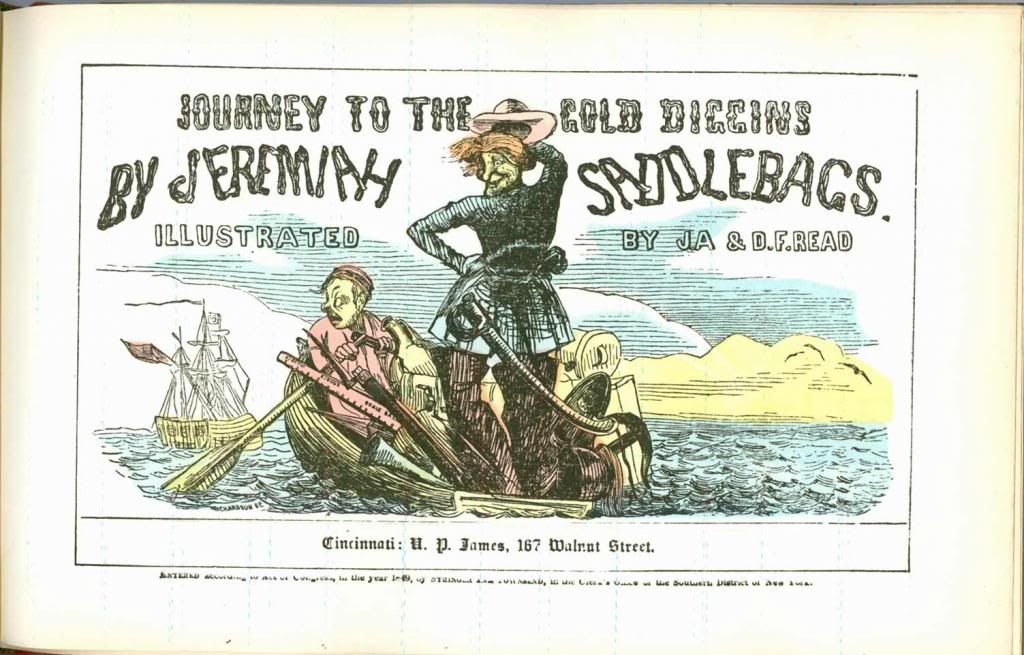
[font:Times New Roman]Bob, that's interesting, but not ground-breaking, IMO. That could just as easily be a label on a mid-19th century tuna can. To get any context the entire book needs to be seen and evaluated.[/font]
OK, have your tuna can fun. It is a long sequential art story. I agree, it needs to be reprinted and placed out for others to read.
Here now are some American home grown examples of early comic strips. First up is the cover to Elton's Comic Almanac for 1853.
[font:Times New Roman]Interesting and quaint, but again, it doesn't provide any gosh-wow revelation for comic book origins. IOW, another tenuous connection.[/font]
and two pages of a longer comic strip story contained therein.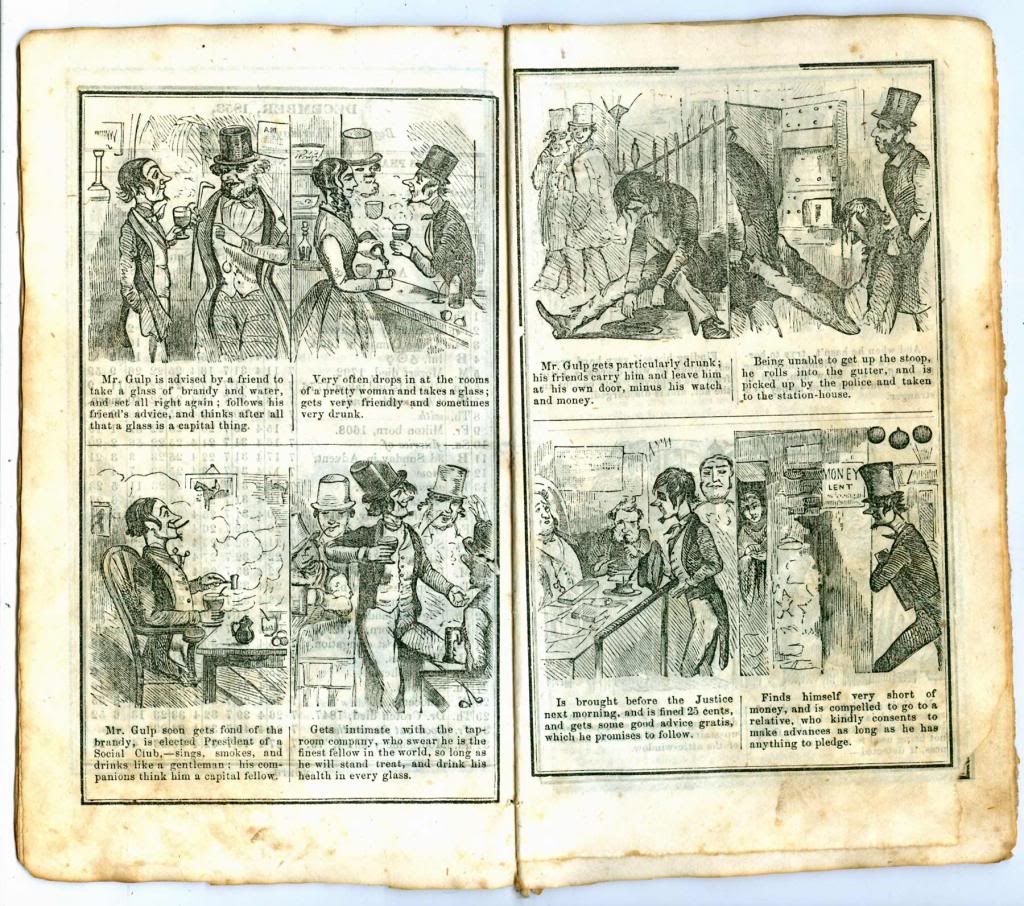
[font:Times New Roman]In desperation Bill Gaines tried to revive this in his Picto-Fiction line. Alas, the results were less than spectacular and suggest a failed branch of the comic evolutionary tree.[/font]
Huh? Bill Gaines? Either sarcasm on your part or simply lack of seeing very many - if any, I suspect - comic strips from the 1800s. There are 1000s of comic strips in 100s of pubs from the 1800s.
Now, here are just a few of the hundreds of comic strips inside Wild Oats, an irreverant magazine akin to a National Lampoon of its day. This seminal weekly periodical, akin to a weekly Sunday newspaper, is incredibly rare. I have exactly three issues in my collection after more than a decade of fruitless searching. There are broken runs in a few institutions of higher learning. Not one of these places I found has even a near complete run. Lost is dust bowls of history, way too long over-looked by almost every comics historian seeking to impart "truth" as it were. I indexed what is in Overstreet about a decade ago now.This first example is by Frank Bellew Sr whom we aptly named "Father of the American comic strip starting in the first Victorian article in OPG #32 2002. Forget Richard Outcault and/or Yellow Kid being the first of ANYTHING.
Frank Bellew Sr was hugely prolific doing many many hundreds of comic strips beginning in the early 1850s. This nice example dates circa 1873, I feel lazy right now, am devoting too much time here as it is from what I have to get accomplished today for my "real" life and am not looking for the exact issue number. Maybe later. but please scope out the detail in this wonderful art
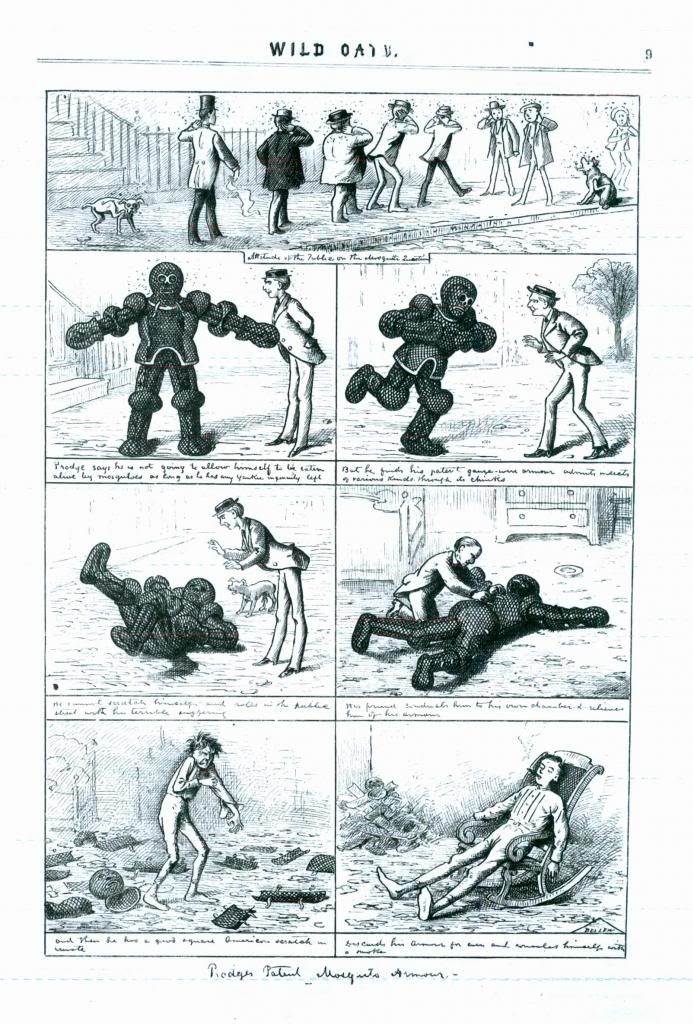
Now here is an example by Livingston Hopkins who also did wonderful comic strip work. This example dates to circa the same year 1873 or so. Hopkins moved to Australia some time later and became that country's premiere political cartoonist according to some history books I gleaned info about him.
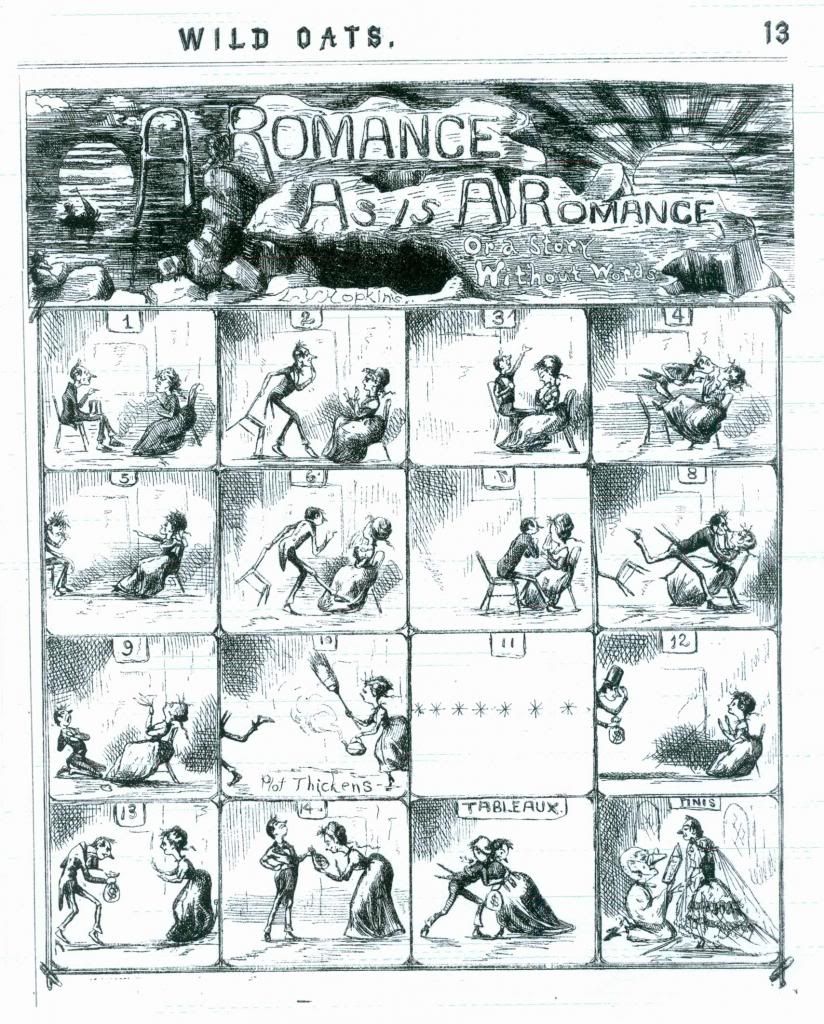
and this last example for today is by one Palmer Cox who some years later went on to create The Brownies. Outcault patterned a lot of his activities with Yellow Kid, but especially Buster Brown, on what Cox was doing with the Brownies.
But prior to The Brownies Palmer Cox was doing detailed sequential comic strips. This example dates from 1875. This is a double page spread. He created many double page spread comic strips for Wild Oats
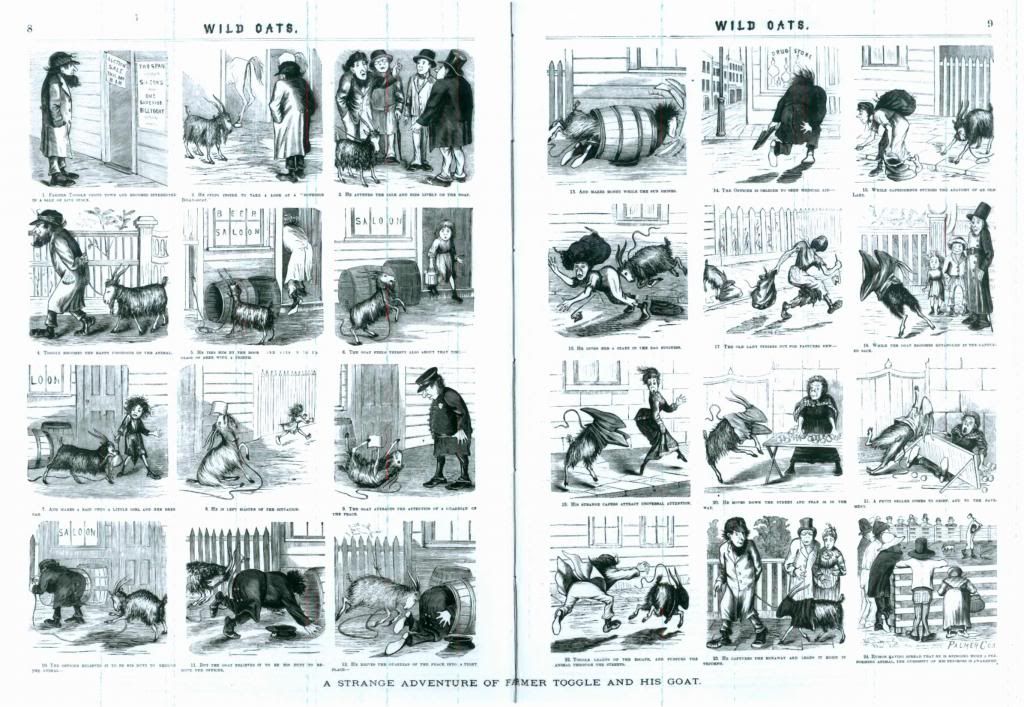
The American comic strip prior to Outcault creating Yellow Kid has thousands of examples in hundreds of publications. I would think those who cling to their myths simply have not seen very many yet.
For good measure am tossing in the cover to the 1908 The Three Funmakers which is the first "anthology" comic book published with more than a single character strip. This comic book is fairly scarce these days. I love it.
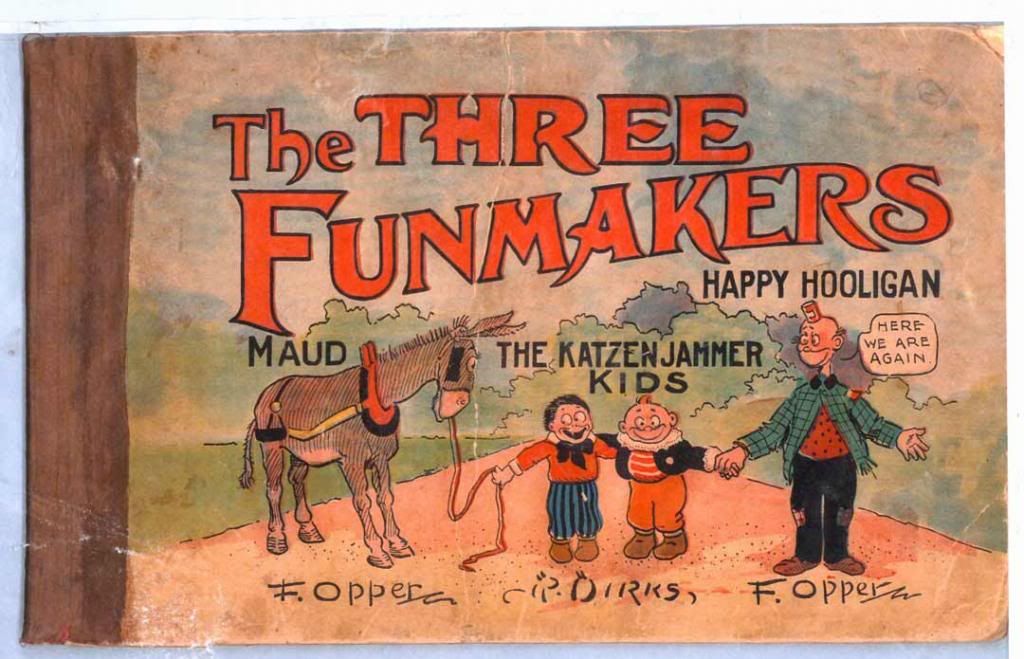
[font:Times New Roman]Very impressed by the depth and scholarship of your work even though I differ with you somewhat about it's direct relationship with comics as we know them today.[/font]

I presented just a very few of what i have as examples here. So you "differ" in what way? The three presented are very much sequential comic strips as "we" know them today. Brings to mind on one level the format used by Hal Foster in Prince Valiant from 1937 onwards, a "comic strip," never using word balloons. And the one presented with out words at all, also sequential comics.
Obviously, I did not address all of your "points" as some of your statements simply make no sense to even begin to attempt to understand actual intent on your part of where you came up with what you have here. My apologies.....
I have no point to make, or have any rebuttal for the points made above.
I am just quoting for those who like to scroll.
You son of a spoon! I lol'd.
Good to see you posting again (thumbs u
All I want for Christmas Richard, is for you to find that thread where you say Metropolis is like a hot girl with 2 huge boobs. Every time I see your username I think of that and laugh. How's my old Pep 33 9.2 CGC?
-
[font:Times New Roman]I concur on this viewpoint, the caveat being that some things have had a much greater influence on that development than others. Some connections are tenuous at best and others are virtual dead-ends.
which really doesn't say anything
http://en.wikipedia.org/wiki/Gershon_Legman
[font:Times New Roman]While Love and Death is a fascinating read, Legman's scholarship is debatable although that isn't quite the word that comes to mind given his prurient interest in the erotic.
 [/font]
[/font] I referenced Love & Death only to ID the man to some of those (not you) who might not recognize who he is. His 'scholarship' (I agree with your assessment BTW, and one can draw a line to LG's L&D article to Wertham's later SOTI) as such in L&D has no relation to the article in a years earlier magazine wherein Legman discusses early 1800s comic books. It is quite long.
Some where in my computer files I have a transcription of this fascinating Legman article which became the foundational basis for searching out 1800s comic books when we began the work to add in 1800s comic books in to what was then still a "Platinum" price index section of OPG. I transcribed it back in 1999
[font:Times New Roman]I applaud this if for no other reason than the Platinum expansion of the Guide into the history of Victorian illustration art provides a deeper understanding of the genealogy of the comic family tree.
That said, I'm resistant to making too many direct connections to the theoretical origins of comics in a guide that also has as it's main criteria establishing a baseline for investment values. Some of the branches of the family tree are dead-ends and have little to do with the evolution of comics as we know them today.
From a collecting standpoint Platinum books have less market potential to comic collectors because the interest is going to be narrower and much more specialized. My
 [/font]
[/font]In all actuality I agree with you regarding the "investment" aspects of these earlier comic books and extend that thought to the 20th century comic books as well. I think many a comic book bringing in "record" prices to be 4th Stage Tulip Mania ie the "bigger fool" theory. At some point the reality of "gravity" is going to snap back on what people think of as their "investments" in the current rarified high end comic book market.
One can already "see" a lot of 40s comic books garnering less interest than in days of yore as the "custome base" simply is dying off for many of the 40s comics.
I vehemently disagree re OPB not being a proper vehicle to have initially presented the data then being uncovered more than a decade ago now. The "origins" of the comic book as presented in OPG for some 15 years now were vetted by a world wide group of comics collector scholar friends of mine.
What ended up in OPG and which has evolved over the years there, in many a case "older" presented data being force dropped out due to space constraints - those last few years I still had interest in building in OPG they held my sections to an aggrecate of 72 pages -
The late Gabriel Laderman NYC had a HUGE holdings in 18th & 19th century American humor pubs, thousands of examples, of which his comics stuff was a more minor sub-set. I gleaned a couple hundred out of his collection aloneI, also, once upon a time, tied in the Sunday Color-printed comics sections which cranked up in the 1890s, however, use of comic strips as a selling point in that sort of periodical actually dates back to the 1850s and was wide spread by the early 1870s with such pubs as Wild Oats among many others. One can check out how far I got in indexing Wild Oats for the Vict section of Overstreet.
[font:Times New Roman]Again, the minutiae isn't what collectors find persuasive. Arguable facts tend to supersede tenuous theoretical connections if a strong enough foundation is laid.
The success of the Yellow Kid and the development of Sunday color comic strips though Buster Brown, Little Nemo et. al., has a direct connection to the evolution of comic books. Obediah Oldbuck's contribution is much less obvious except as historical anecdote and from a marketing standpoint it's a tough sell. [/font]
Huh? You are simply wrong and make no sense. Comic Strips in Books and periodicals in all their varied myriad formats have been evolving in the USA since 1842. Yellow Kid is not a comic strip - simply a large single panel ilustration to an accompanying text by Townsend - until its last half dozen apperances and presents nothing which is not already "invented". Simple Fact.
Color? "Daily" newspaper comic strips now become not part of your equation. One must simply throw out all of the Cupples & Leon black and white comic books from 1919-1933; or to bring it in to more "modern" times, stuff like Zap Comics, Slow Death, on in to Cerebus, Elfquest, etc etc etc?
All I have presented here are a few thumb nail sketches.
You keep bringing up concepts of "....marketing standpoint it's a tough sell..." which makes me wonder your intent of replying to the snippets I presented in the first place. All three of the history articles as I worked on them inside Overstreet covering 1840s-1880s, 1880s-1930s and "Origins of the Modern Comic Book" have zero hints of marketing same for bucks.
[font:Times New Roman]The early origins of the word balloon are relevant, but far less important than it's wide-spread use. It's origins are quaint, but it's implementation later on as part of a package that included sequential art and color was in response to a need of the expanding medium.[/font]
Huh? The above statement makes no sense other than fulfilling a need by you to think refutation is important. What you wrote here makes no sense.
Here is a colored in title page to America's first home grown stand alone comic book dating from 1849:
[font:Times New Roman]Bob, that's interesting, but not ground-breaking, IMO. That could just as easily be a label on a mid-19th century tuna can. To get any context the entire book needs to be seen and evaluated.[/font]
OK, have your tuna can fun. It is a long sequential art story. I agree, it needs to be reprinted and placed out for others to read.
Here now are some American home grown examples of early comic strips. First up is the cover to Elton's Comic Almanac for 1853.
[font:Times New Roman]Interesting and quaint, but again, it doesn't provide any gosh-wow revelation for comic book origins. IOW, another tenuous connection.[/font]
and two pages of a longer comic strip story contained therein.
[font:Times New Roman]In desperation Bill Gaines tried to revive this in his Picto-Fiction line. Alas, the results were less than spectacular and suggest a failed branch of the comic evolutionary tree.[/font]
Huh? Bill Gaines? Either sarcasm on your part or simply lack of seeing very many - if any, I suspect - comic strips from the 1800s. There are 1000s of comic strips in 100s of pubs from the 1800s.
Now, here are just a few of the hundreds of comic strips inside Wild Oats, an irreverant magazine akin to a National Lampoon of its day. This seminal weekly periodical, akin to a weekly Sunday newspaper, is incredibly rare. I have exactly three issues in my collection after more than a decade of fruitless searching. There are broken runs in a few institutions of higher learning. Not one of these places I found has even a near complete run. Lost is dust bowls of history, way too long over-looked by almost every comics historian seeking to impart "truth" as it were. I indexed what is in Overstreet about a decade ago now.This first example is by Frank Bellew Sr whom we aptly named "Father of the American comic strip starting in the first Victorian article in OPG #32 2002. Forget Richard Outcault and/or Yellow Kid being the first of ANYTHING.
Frank Bellew Sr was hugely prolific doing many many hundreds of comic strips beginning in the early 1850s. This nice example dates circa 1873, I feel lazy right now, am devoting too much time here as it is from what I have to get accomplished today for my "real" life and am not looking for the exact issue number. Maybe later. but please scope out the detail in this wonderful art

Now here is an example by Livingston Hopkins who also did wonderful comic strip work. This example dates to circa the same year 1873 or so. Hopkins moved to Australia some time later and became that country's premiere political cartoonist according to some history books I gleaned info about him.

and this last example for today is by one Palmer Cox who some years later went on to create The Brownies. Outcault patterned a lot of his activities with Yellow Kid, but especially Buster Brown, on what Cox was doing with the Brownies.
But prior to The Brownies Palmer Cox was doing detailed sequential comic strips. This example dates from 1875. This is a double page spread. He created many double page spread comic strips for Wild Oats

The American comic strip prior to Outcault creating Yellow Kid has thousands of examples in hundreds of publications. I would think those who cling to their myths simply have not seen very many yet.
For good measure am tossing in the cover to the 1908 The Three Funmakers which is the first "anthology" comic book published with more than a single character strip. This comic book is fairly scarce these days. I love it.

[font:Times New Roman]Very impressed by the depth and scholarship of your work even though I differ with you somewhat about it's direct relationship with comics as we know them today.[/font]

I presented just a very few of what i have as examples here. So you "differ" in what way? The three presented are very much sequential comic strips as "we" know them today. Brings to mind on one level the format used by Hal Foster in Prince Valiant from 1937 onwards, a "comic strip," never using word balloons. And the one presented with out words at all, also sequential comics.
Obviously, I did not address all of your "points" as some of your statements simply make no sense to even begin to attempt to understand actual intent on your part of where you came up with what you have here. My apologies.....
I have no point to make, or have any rebuttal for the points made above.
I am just quoting for those who like to scroll.
You son of a spoon! I lol'd.
-
2002
towards2112, FlyingDonut, gman, ArAich, greggy, fingfangfoom, Chromium, supapimp, Bronzebruce13, CaptainOfIndustry, valiantman, drummy, nearmint, Zonker, Architect, dena, SilverandBronze, chrisco37, bronty, fantastic_four, mr_highgrade, comic paradox, sborock, TheVisitor, joe_collector, awe4one, tkg2627, scottish, clobberintime, ComicDiva89, comiclink, comicwiz, comix4fun, delekkerste, Borg, drbanner, drice6900, darthdiesel
2003
Shield, r100comics, Scrooge, Earl, BrianR, WEBHEAD, goldust40, sckao, Theagenes, detective27kid, Flaming_Telepath, Aces, Silver, shiverbones, Silver, sakaridis, 500Club, BurntBoy, seank, newerthannew, Mephisto, Calamerica, the_beyonder, tth2, DCEng, Aman619, Methuselah, Hammer : )
2004
xsmanx, JordanScott, r1970d, Stronguy, namisgr, Currin Comics, marvelcollector, toro, Buck Biggins, Norinn Radd, bounty_coder, iggy, nerfherder-3, comicdey, FFB, FUELMAN, cosmic-spider-man,
2005
Sal, kingofrulers, Crows, Cryptkeeper59, theHumanTorch, John72tex, RockMyAmadeus, BigMike, JmC, Benz, Point Five, Inhuman Fiend, GACollectibles, comicdonna
2006
joeypost, nepatkm, lookwhoitis, MCMiles, thirdgreenham, Monstro, TimMaY, DrWatson, Korvac Saga, Ciorac (2004*), Karma23, Superman2006, ernster, Dark Knight, piper, SolitaireOne, JohnT, Loki
2007
BlowUpTheMoon, MacMan, Count, blue808, Mr. Diggler, trmoore54, cheetah, bosco685, MR. COMICBOOK, JazzMan, bronze_rules, Spidermanontilt, Designer Toast, TupennyConan, shark2557, snitzer, rtarturo, almoe, the shadow knows, cloudofwit, Dale Roberts, nwpassage, Big Daddy, Doctor Svord, Annihilus, szelim, drewincanada, telerites
2008
Comicopolis, Boozad, Nmtg9, Dollarbill, PEP, Black Lantern, Junkenstein99, Cimm, ShortstackComics, Universal Soldier, Lebowski, Beau, jeBailey, oakman29, Insaneclown
2009
slym2none, ashsaytr, marino1, gladuchka99
-
Kudos to 143ksk - Always a pleasure to do business with - packs well, and slightly undergrades. Plus he like Archie, so how bad could it be?
Shawn
-
My vote goes to Pep Comics #22, December 1941. The question wasn't "which cover" it was "which book". The fact that you had a superhero on the cover protecting the USA from the Axis powers (both Japanese and German swastika on the boot) 2 months before the United States entered the war (book was on the stands in Oct '41) plus the fact that Archie Andrews made his debut. I mean who would ever suspect that wholesome little Archie, Betty and Jughead would be in the back of a book with that cover. That's like finding a Donald Duck story in an EC Comic...
Now if we're talking which COVER represents the golden age, I'd go with Superman #17 or an early Marvel Mystery...
-
and the granddaddy of my last heritage wins...also a prime pressing candidate (bc flaws, etc)....would get a 6.0 IMO
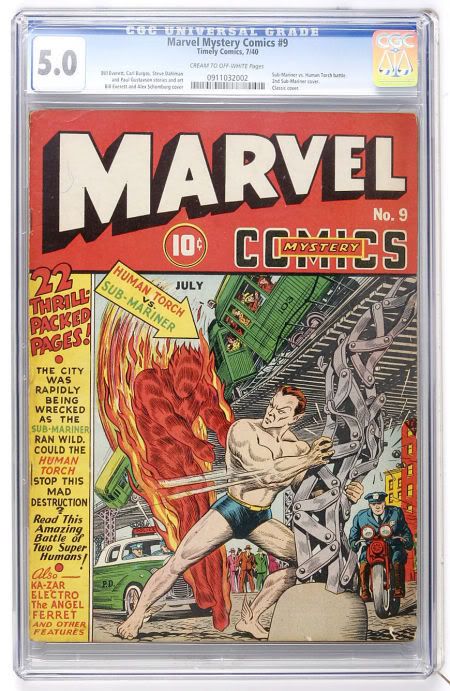










.thumb.JPG.ece55f45fba8bf58320032ec290c530a.JPG)

Marvel Comics #1, October or November 1939. How rare are the OCT dated copies?
in Golden Age Comic Books
Posted
I've seen and held one about 20 years ago - it was in one of those old school fotress holders. Same guy at the time had a pedigree copy of Detective #27 and I was allowed to hold it and read it with my grubby hands (later was graded a Blue 6.5). That was one of the greatest comic book days of my life.